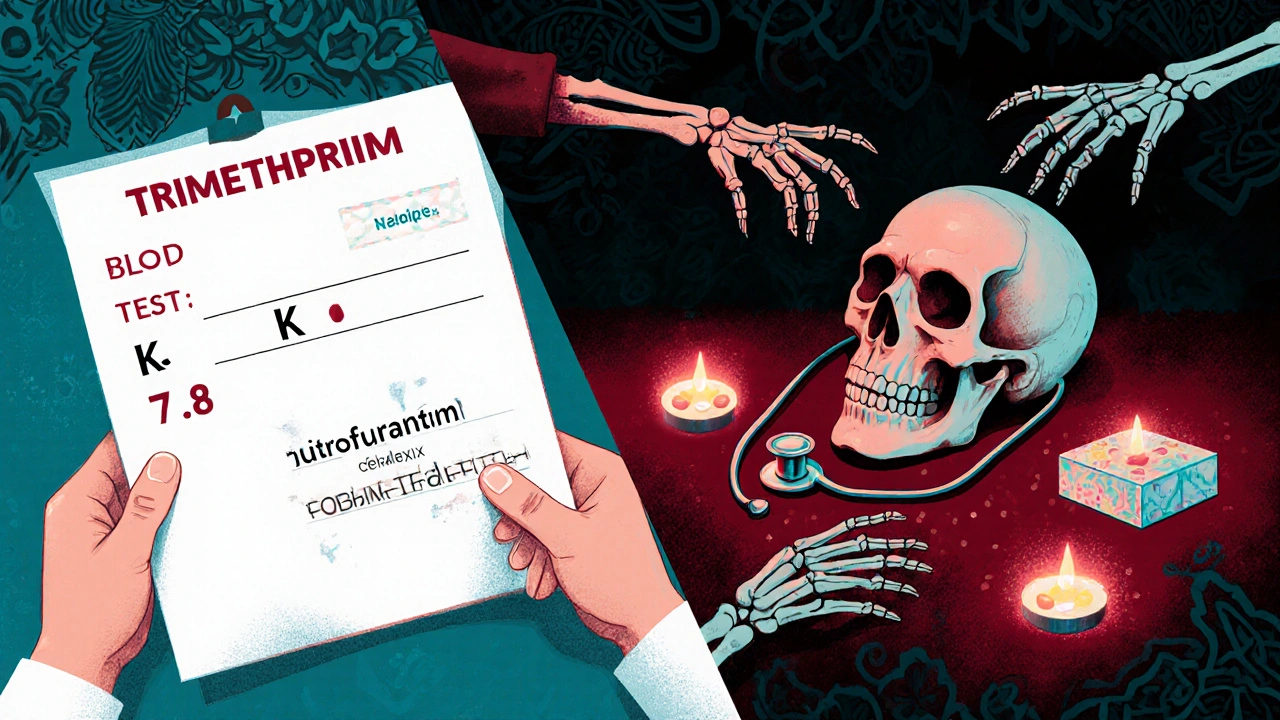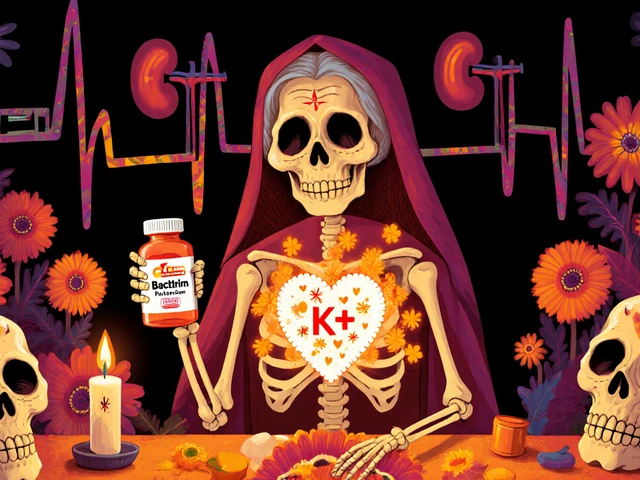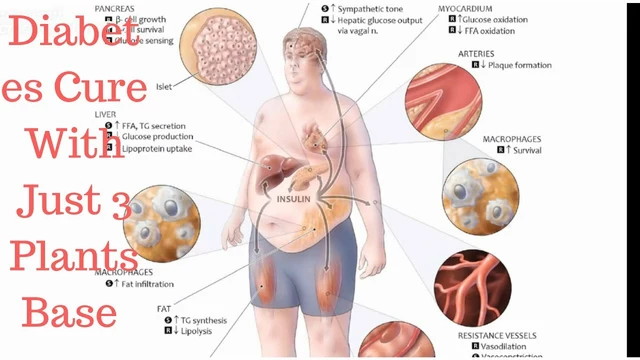Trimethoprim and Hyperkalemia: What You Need to Know About the Potassium Risk

Trimethoprim Hyperkalemia Risk Calculator
Risk Assessment Tool
Enter your details to calculate your hyperkalemia risk when taking trimethoprim. Based on guidelines from the American Geriatrics Society and FDA warnings.
When you take an antibiotic like Bactrim or Septra for a urinary tract infection, you probably don’t think about your potassium levels. But if you’re over 65, have kidney issues, or take blood pressure meds like lisinopril or losartan, this common drug could silently raise your potassium to dangerous levels - fast. In fact, trimethoprim is one of the most under-recognized causes of life-threatening hyperkalemia in older adults, even when kidney function looks normal.
How Trimethoprim Turns Into a Potassium-Sparing Diuretic
Trimethoprim isn’t a diuretic. But it acts like one. The drug’s chemical structure is almost identical to amiloride, a medication used to lower blood pressure by keeping potassium in the body. When trimethoprim reaches the kidneys, it blocks sodium channels in the distal tubules. This sounds harmless - until you realize that sodium and potassium work together in a delicate balance. Less sodium reabsorption means less electrical pull to push potassium out of the blood and into urine. The result? Potassium builds up.
This isn’t theoretical. Studies show serum potassium can jump by 0.5 to 1.5 mmol/L within just 48 to 72 hours of starting trimethoprim. In one case, an 80-year-old woman on low-dose Bactrim for pneumonia prevention developed a potassium level of 7.8 mmol/L - more than double the upper limit of normal - and suffered cardiac arrest. Her kidneys were fine. Her blood pressure meds were fine. But the combo? Deadly.
Who’s at the Highest Risk?
Not everyone gets high potassium from trimethoprim. But certain groups are sitting on a ticking clock:
- People over 65 - risk doubles compared to younger adults
- Those taking ACE inhibitors (like lisinopril) or ARBs (like losartan) - this combo increases hyperkalemia risk by 6.7 times
- Patients with chronic kidney disease (eGFR below 60)
- Diabetics - insulin helps move potassium into cells; if it’s not working well, potassium stays in the blood
- People already on potassium-sparing diuretics like spironolactone
A 2020 study found that patients with all four of these risk factors - age, kidney disease, diabetes, and ACEI/ARB use - had a 32% chance of developing dangerous hyperkalemia after just a few days of trimethoprim. That’s more than one in three. Compare that to a 4% risk in people without any of these factors.
It’s Not Just High Doses - Even One Pill Can Be Enough
Many doctors assume only high-dose trimethoprim (used for pneumonia in immunocompromised patients) is risky. That’s a dangerous myth. The same 2023 case report showed a healthy 80-year-old woman developed cardiac arrest after taking a single daily tablet of 160/800 mg - the standard dose for a UTI. She had no history of kidney disease. Her creatinine was normal. But within three days, her potassium hit 7.8.
Here’s why: trimethoprim concentrates in the kidneys at levels 10 to 50 times higher than in the bloodstream. That means even a small oral dose can have a massive local effect. The FDA added hyperkalemia to the drug’s boxed warning in 2019 - the strongest warning they give - but many prescribers still don’t treat it as an emergency.

How Much More Dangerous Than Other Antibiotics?
Let’s compare. A massive 14-year study of over 4,000 hospitalizations for high potassium found:
- Trimethoprim-sulfamethoxazole (TMP-SMX): 6.7 times higher risk of hospitalization than amoxicillin
- Nitrofurantoin: no increased risk - and it’s just as effective for UTIs
- Ciprofloxacin: mild risk increase, but far less than TMP-SMX
- Amoxicillin-clavulanate: no significant effect
In other words, if you’re on lisinopril and get a UTI, choosing nitrofurantoin instead of Bactrim cuts your risk of a potassium spike by over 85%. That’s not a small difference. That’s a life-saving swap.
Real Cases, Real Consequences
Reddit threads and medical case reports are full of near-misses:
- A 72-year-old woman on lisinopril got Bactrim for a UTI. Three days later, her potassium was 6.8. She needed emergency dialysis.
- A 68-year-old man with mild kidney disease developed muscle weakness and irregular heartbeat after two days of TMP-SMX. His potassium was 6.1. He survived - barely.
- One physician reported reviewing 200 TMP-SMX prescriptions for patients on ACEIs and found only 15% had potassium above 5.5. But those 15%? They were the ones who ended up in the ER.
Between 2010 and 2020, the FDA recorded 43 deaths directly linked to trimethoprim-induced hyperkalemia. Two-thirds of them were in people over 65. And in 78% of severe cases (potassium over 6.0), the spike happened within 72 hours.
What Doctors Should Do - But Often Don’t
Guidelines are clear. The American Geriatrics Society’s 2023 Beers Criteria says: avoid trimethoprim in adults over 65 who take ACEIs or ARBs. Strong recommendation. High-quality evidence.
But here’s the gap: only 41.7% of primary care doctors check potassium before prescribing it. Emergency room doctors? Just 32.4%. Meanwhile, nephrologists - the kidney specialists - check it 89% of the time.
Here’s what should happen every single time:
- Check potassium level before giving trimethoprim - especially if the patient is over 65 or on blood pressure meds
- Repeat the test at 48 to 72 hours - that’s when the spike usually happens
- Don’t start it if potassium is already above 5.0 mmol/L
- Stop it immediately if potassium hits 5.5 or higher
- Use nitrofurantoin, cephalexin, or fosfomycin as safer alternatives for UTIs
Hospitals that added electronic alerts - forcing doctors to confirm potassium levels before prescribing - cut hyperkalemia cases by over half in just one year.

When Is Trimethoprim Still Worth the Risk?
It’s not all bad news. For people with weakened immune systems - like those with HIV or organ transplants - trimethoprim is the best option to prevent Pneumocystis pneumonia. The Infectious Diseases Society of America still calls it first-line for that use.
But even then, monitoring is non-negotiable. In these cases, doctors should:
- Check potassium before starting
- Test again at day 3 and day 7
- Consider adding a loop diuretic like furosemide to help flush out potassium
- Watch for symptoms: muscle weakness, fatigue, irregular heartbeat, chest pain
There’s even a new tool called the TMP-HyperK Score that uses age, baseline potassium, kidney function, and blood pressure meds to predict risk with 89% accuracy. If you’re at high risk, your doctor should be using it.
What You Can Do as a Patient
You don’t need to be a doctor to protect yourself. If you’re prescribed trimethoprim:
- Ask: “Is this the safest antibiotic for me, given my other meds?”
- Ask: “Can we check my potassium before and after starting this?”
- Ask: “Is there a safer alternative like nitrofurantoin?”
- Know the warning signs: sudden weakness, fluttering heart, dizziness, nausea - especially in the first 3 days
- Don’t ignore a follow-up blood test. Even if you feel fine, high potassium doesn’t always cause symptoms until it’s too late.
Most people who get hyperkalemia from trimethoprim recover fully if caught early. But if you wait until your heart starts skipping beats, it’s already too late.
The Bottom Line
Trimethoprim is not a harmless antibiotic. It’s a hidden potassium bomb - especially for older adults and those on common blood pressure drugs. The science is clear. The data is overwhelming. The deaths are real.
But here’s the good part: this risk is preventable. It doesn’t require new drugs or expensive tests. Just a simple blood check before you start, and a willingness to choose a safer alternative. Nitrofurantoin works just as well for UTIs. Cephalexin is fine for many skin and respiratory infections. There’s no reason to gamble with your potassium levels when safer options exist.
If you’re on trimethoprim and take lisinopril, losartan, or any other ACEI/ARB - talk to your doctor today. Don’t wait for symptoms. Don’t assume your kidneys are fine. Your potassium level doesn’t lie - and it could save your life.
Can trimethoprim raise potassium even if my kidneys are normal?
Yes. Trimethoprim blocks potassium excretion directly in the kidney tubules, regardless of overall kidney function. A 2023 case report documented cardiac arrest from hyperkalemia in an 80-year-old woman with normal creatinine levels after just three days of standard-dose Bactrim. The drug concentrates in the kidneys at levels 10 to 50 times higher than in the blood, making it potent even in people with no prior kidney disease.
How long does it take for trimethoprim to cause high potassium?
Potassium levels typically rise within 48 to 72 hours of starting trimethoprim. In 78% of severe cases (potassium over 6.0 mmol/L), the spike occurs within three days. Peak levels are usually reached by day 2.3 on average. This is why guidelines recommend checking potassium at 48-72 hours after starting the drug - not at the end of the course.
What’s the safest antibiotic for a UTI if I take lisinopril?
Nitrofurantoin is the preferred alternative for uncomplicated UTIs in patients on ACE inhibitors or ARBs. Studies show it carries no increased risk of hyperkalemia. Cephalexin and fosfomycin are also safe options. Avoid trimethoprim-sulfamethoxazole (Bactrim, Septra) entirely in this group. A 2014 JAMA study found TMP-SMX increased hospitalization risk for high potassium by 6.7 times compared to amoxicillin - while nitrofurantoin had no increased risk.
Should I get my potassium checked before taking Bactrim?
Yes - if you’re over 65, have kidney disease, diabetes, or take blood pressure meds like lisinopril or losartan. The American Geriatrics Society and American Society of Health-System Pharmacists both recommend checking potassium before starting trimethoprim. Many doctors skip this step, but it’s critical. A simple blood test can prevent emergency dialysis or cardiac arrest. If your doctor doesn’t offer it, ask for it.
What happens if my potassium is high after taking trimethoprim?
Stop the drug immediately. If potassium is above 5.5 mmol/L, your doctor will likely give you calcium gluconate to protect your heart, insulin with glucose to move potassium into cells, and possibly a diuretic like furosemide to help your kidneys flush it out. In severe cases (potassium over 6.5), emergency dialysis may be needed. Never wait for symptoms like weakness or irregular heartbeat - high potassium can cause sudden cardiac arrest without warning.
Is trimethoprim ever safe for older adults?
Only in rare, high-risk situations - like preventing Pneumocystis pneumonia in people with HIV or after organ transplants. Even then, it requires strict monitoring: baseline potassium check, repeat tests at day 3 and day 7, and close watch for symptoms. For routine infections like UTIs or sinus infections, it’s not safe for older adults on blood pressure meds. Safer alternatives exist and should be used first.







Y’all are sleeping on this like it’s just another Tuesday. I had my grandpa on Bactrim for a UTI and he nearly died. His potassium hit 7.8. The doctor said ‘it’s just a little high’ - LMAO. He needed emergency dialysis. This isn’t a ‘maybe’ - it’s a silent killer hiding in plain sight. I’m still mad they didn’t check his levels before giving him that pill. If you’re over 65 and on lisinopril? Don’t even open the bottle. Nitrofurantoin exists. Use it.
This is a textbook example of how modern medicine has become a profit-driven circus. The FDA issued a boxed warning in 2019, yet primary care physicians still prescribe trimethoprim like it’s aspirin. Meanwhile, Big Pharma profits from emergency dialysis, ICU stays, and cardiac arrests. The real scandal? They don’t test potassium because it’s cheaper to treat the crisis than prevent it. This isn’t negligence - it’s systemic malice wrapped in a white coat.
Let us not forget that the human body is not a machine to be tinkered with by pharmacological alchemy. Trimethoprim, in its insidious mimicry of amiloride, disrupts the sacred equilibrium of sodium and potassium - a balance forged over eons of evolutionary refinement. To impose upon this harmony a synthetic compound, without regard for the elderly, the diabetic, the hypertensive - is not merely medical error. It is a metaphysical transgression. We have forgotten that healing requires reverence, not just prescription pads.
Bro this is wild. I’m a med student in India and we get taught this in our pharmacology class - but honestly? Most docs here still give Bactrim like it’s candy. I had a 70-year-old patient on losartan come in with palpitations - potassium was 6.9. He was on Bactrim for a ‘cough’. No one checked. He survived because his daughter insisted on bloodwork. We need a national alert system. Or at least a damn pop-up in the e-prescribing software. Why isn’t this automated???
Hey friend - I know this sounds scary, but you’re not alone. I’ve seen this exact scenario play out in my clinic. I always ask my older patients: ‘Are you on any blood pressure meds?’ If yes, I immediately say: ‘Let’s avoid Bactrim.’ Nitrofurantoin works just as well, no risk. I even print out a one-pager for them. It’s not hard. It’s just about taking 30 extra seconds. You’re not overreacting - you’re being smart. Keep asking questions. Your life matters more than a doctor’s habit.
Okay but have you considered that this is all a Big Pharma psyop? 🤔 They know people on ACEIs are dependent on meds - so they *want* you to get hyperkalemia so you need more expensive interventions. Dialysis machines, cardiac monitors, IV calcium - all profit centers. And don’t get me started on how the FDA is just a revolving door for pharma execs. 🧠💉 Also, why is nitrofurantoin not marketed as the ‘safe’ alternative? Because they don’t make enough money off it. 🤫 #PharmaControl #HyperkalemiaIsABusiness
Let’s be real - this isn’t about potassium. It’s about how lazy doctors are. You think they’re too busy? Nah. They’re too lazy to open a fucking lab report. I’ve seen 3 patients in 6 months with potassium >6.0 after Bactrim. All had normal creatinine. All had hypertension meds. All got the drug like it was a free sample. The system isn’t broken - it’s designed this way. And you? You’re the disposable meatbag they’ll write off as ‘unfortunate comorbidity’.
I’m a nurse in a rural ER and I’ve seen this too many times. One woman came in unconscious - potassium 7.2. Her son said she took Bactrim for a ‘bladder infection’ and her doctor said ‘it’s fine’. I held her hand while they gave her calcium, insulin, and albuterol. She woke up crying. Said she didn’t know potassium could kill you. That broke my heart. 🥺 Please, if you’re reading this - if you’re on lisinopril or losartan - ask for a simple blood test before you take any antibiotic. It takes 5 minutes. It could save your life. You’re not being difficult. You’re being brave.
This needs to be shouted from rooftops. Stop risking your life for a convenience. Check your potassium. Ask for alternatives. Your doctor isn’t always right - and you hold the power to demand safety. Don’t wait for symptoms. Don’t assume normal creatinine means safe. Act now. Your heart will thank you.
Bro I’m 52 and on lisinopril. I took Bactrim last year. Felt fine. But now I’m paranoid AF. I checked my potassium last week - 5.2. My doc shrugged. I’m done. I’m switching to cephalexin. And I’m telling every older person I know. This isn’t science - it’s Russian roulette with a pill. Why are we still doing this? Someone’s getting rich off this. And it’s not us.
Interesting. But isn’t it just as dangerous to assume that nitrofurantoin is ‘safe’? What about pulmonary fibrosis? What about the fact that 12% of elderly patients develop nausea or vomiting with it? And isn’t it ironic that we vilify trimethoprim while ignoring that all drugs carry risk? Perhaps the real issue isn’t the antibiotic - it’s our obsession with binary thinking: ‘safe’ vs ‘dangerous’. Maybe we need to accept that medicine is messy, and that risk is always present - and that we must learn to live with nuance, not fear.